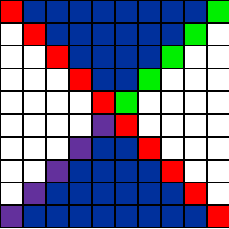 |
 |
|
|||||
|
|||||||
 |
|
|
© 2006 Sacred Heart School. All rights reserved. Archdiocese of Kansas City in Kansas |
|
Hundredths and Adding Decimals
Objective: Review hundredths and adding decimals
Modeling: Demonstrate the process, asking for the student to give the answers.

SAMPLE
- Show the student a square divided into 100 equal sections, with the sections colored in a pattern of at least three colors, plus white (blank) squares. Ask how much one of the sections is worth. (one hundredth).
- Ask the student to count the number of one color of squares (sample: red = 10 squares). Then ask how much of the entire square is that color (ten hundredths). Finally, ask the student how to write that amount as a decimal (0.10). Repeat this for the remaining colors, ending with white. I usually do all of the "colored" boxes, and then ask if I've counted all of the squares. Someone will realize that we left out the white, so we'll then include those in our list. (Sample: red = 0.10, green = 0.05, purple = 0.05, blue = 0.40, white = 0.40)
- Next, ask the student how many hundredths there should be of all the colored boxes together (one hundred hundredths) and how to write it in decimal form (1.00). If she/he can't tell you how to write it correctly the first time, write it out as the student dictates, and then help him/her read it aloud; then have him/her adjust the answer. (For example, if the student says 0.100, help her/him to read "zero and one hundred thousandths" and then adjust the decimal to have a correct answer.)
- Explain that we can use that fact to check our counting of the colored boxes. If we add all of the decimal representations for the colored portions, the answer should be 1.00! If it is not, we know either the addition was incorrect, or the counting was incorrect.
- Walk the student through recording the decimals in a vertical column, with the decimal points correctly aligned, and then finding the sum.
Have the student perform the same process as before, with a differently colored square. The teacher should help as needed, but encourage the student to verbalize what should happen next, and refer back to the modeled process to self-check.
Independent Practice:
- Give the student a blank hundredths square, and have him/her color it in any pattern he/she would like, using at least four colors.
- If you have more than one student, they may then trade squares to find the decimal representations for each color and add to check. If you have only one student, have her/him record the decimal representation for each color and self-check by adding to get 1.00.
- not recording the color name next to the decimal amount, so the list is ambiguous
- writing the amounts as whole numbers (14) rather than decimals (0.14); remind the student that this would mean there are 14 large squares that are completely one color
- not aligning the decimal points correctly before adding
